Buenos Aires is the capital of Argentina and a meeting with South American atmosphere and countless European-style splendor buildings that make the city unique on the American continent. Buenos Aires was expanded by Parisian example, as Argentina was one of the richest countries in the world, and it is clearly seen in the large and charming city center.
Everywhere there is grand architecture that matches the best of Europe and at the same time creates the city’s very own atmosphere. The central squares, Plaza de Mayo and Plaza Congreso, as well as the stunningly beautiful theater building, Teatro Colon, are fine examples of this. A Calle Florida stroll is also a must, just as tango in San Telmo is also popular.
About 14 million people live in the city and they are called Porteños. They are proud of their city and they clearly appreciate living well, which you as a visitor also enjoy. Buenos Aires is a true paradise for meat eaters, for example, and you can go to a Parisian café in the elegant Tortoni.
The port areas around Puerto Madero, the Recoleta district and the many beautiful parks northwest of the city center are all some beautiful places and facilities, which include some of the many good museums in the Argentine capital. They await your visitor just as the porteños do.
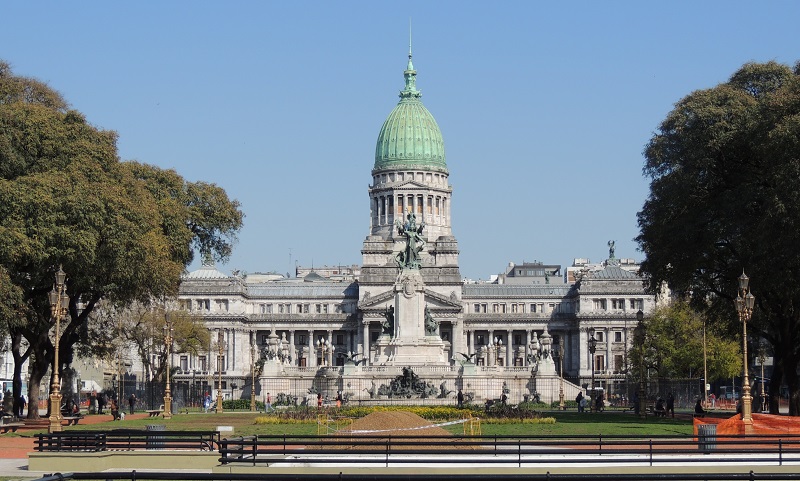
The Palacio del Congreso is a monumental building in central Buenos Aires that is the seat of the Argentine Congress. The congress is called Congreso de la Nación Argentina, and the decision to build it was made in 1895, while the construction itself took place in the years 1898-1906.
It was the Italian architect Vittorio Meano who overall designed the Palace of Congress, and the Argentinian Julio Dormal completed Meano’s drawings. Several artists participated in the decoration, which lasted until 1948. Among the well-known works at the Palacio del Congreso is Victor de Pol’s beautiful quadriga above the main entrance.
The Congress Palace was built in granite and marble with a copper dome on top, which reaches a height of 80 meters. The architectural style is Greco-Roman with elements of the contemporary Beaux-Arts. The inspiration in the self-confident and prosperous Argentina around the year 1900 came from all over the world, and this also applied to the Congress. Thus, the division of its functions was inspired by the Congress in Washington, and at the top the quadriga is enthroned as on Berlin’s Brandenburg Gate.
The palace’s main entrance is called the Entrada de Honor, and it is used for ceremonial events. Behind the stairs and thus inside the Palacio del Congreso, you can see the building’s beautifully decorated halls, all of which were made with the best materials sourced from around the world. The two chambers of Congress and the Salón Rosada, which was decorated by Eva Perón on the occasion of the introduction of women’s right to vote, are examples of the fine and interesting halls.
Avenida de Mayo is Buenos Aires’ grand street, which over a stretch of 1.5 kilometers connects Plaza de Mayo and Plaza del Congreso. Thereby it runs between Argentina’s president’s office building, Casa Rosada, and the country’s political assembly, Congreso de la Nación.
The avenue was laid out 1885-1894 on the initiative of Torcuato de Alvear, who was mayor of Buenos Aires. It was named after the Argentine Revolution of May 1810, which was one of the events leading up to Argentina’s independence from Spain.
A strict building regulation was established for buildings along Avenida de Mayo, where the facade height of the houses could not exceed 24 metres. However, this was sometimes deviated from, and countless noble buildings in the Parisian style sprang up from the beginning of the 20th century. This applied, for example, to Hotel Chile from 1907, Hotel Majestic from 1910 and Palacio Barolo from 1923.
The biggest change since the facility occurred in 1937, when two blocks were demolished to make way for the world’s widest boulevard. It was the 90 meter wide Avenida 9 de Julio, which was laid out perpendicular to Avenida de Mayo. To avoid future changes, the streetscape was protected in 1997, and special approvals are required if building or remodeling is to be done on the splendid avenue.
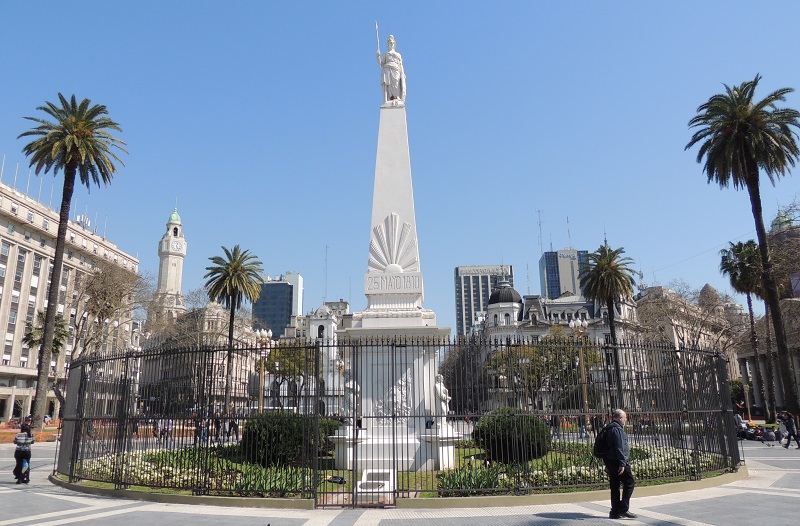
Plaza de Mayo is where Juan de Garay founded Buenos Aires in 1580, and as such the square remains one of the centers of the Argentine capital. Juan de Garay founded it as the Plaza Mayor, also known from Spanish cities such as the capital Madrid. The current square was created in 1884, when a colonnaded building was demolished to join the Plaza de la Victoria (Plaza Mayor) and Plaza 25 de Mayo (Plaza de Armas). The Plaza de Armas had been laid out in 1661, when the local governor acquired the area for the city’s fort.
Plaza de Mayo is surrounded by a number of beautiful and historically significant buildings such as the president’s workplace and Buenos Aires’ cathedral. In the middle of the square you can see the Pyramid of May/Pirámide de Mayo from 1811, which was erected as a monument to the revolution in May 1810, which led to the independence of the area. The monument is a pedestal with an obelisk crowned by an allegorical statue symbolizing freedom.
Political demonstrations regularly take place in the Plaza de Mayo, which as a political center is a natural place to express oneself in larger or smaller gatherings. On October 17, 1945, there were mass demonstrations here for the release of Juan Perón, who later became president. On June 16, 1955, a bomb exploded during a mass meeting held by Juan Perón as president, and for decades after the Falklands War against England in the early 1980s, mothers of fallen or missing sons have demonstrated in the Plaza de Mayo.
Calle Florida is Buenos Aires’ main street, and it is one of the city’s most visited places. Here there is a lovely big-city atmosphere with shops, eateries, stalls, culture, office buildings and much more that provide atmosphere and activity. A walk on the street is thus one of the city’s good places to simply enjoy the sight of the people, the porteños, who also enjoy taking a stroll along Calle Florida.
The history of the street goes back to the founding of the city in 1580. At first it was just a path leading to and from the waters of the Río de la Plata. It was named San José in 1734, and after that development took off. The street was paved with stone from Montevideo in 1789, making it the city’s first to be paved. You can still see a preserved part from the 18th century at the Catedral subway station and Diagonal Norte street.
For a number of years, Calle Florida was called Calle del Correo, which was named after the post office that was to be found along the street in the period around the year 1800. Calle Florida has also had several other names, and over time several well-known events have taken place here.
In 1813, Mariquita Sánchez de Thompson lived in the street, and she was a patriot and one of the city’s well-known people. On May 14 that year, the Argentine national anthem was sung for the first time, and it happened precisely in Mariquita’s house, which thereby entered the history books.
In the 1890s, a tram line was built which ran along Calle Florida, and this gave extra traffic and extra nourishment to the street as a shopping centre. Due to overcrowding, the tram was taken down in 1913, but shopping opportunities continued to grow in the then quite prosperous Buenos Aires. Part of Calle Florida was laid out as a pedestrian street, and several department stores opened their doors. The English Harrods, for example, opened the first Harrods that was not located in the British Isles.
After recessions at the end of the 20th century, buildings in Calle Florida have been restored again, where Galerías Pacifico is a beautiful example of the style from the decades around 1900. In terms of buildings, you can also enjoy other beautiful constructions, and you should go to the intersection of Calle Florida and Avenida Diagonal Norte/Avenida Roque Sáenz Peña, where some of the architectural highlights from the 1910s-1940s are located.
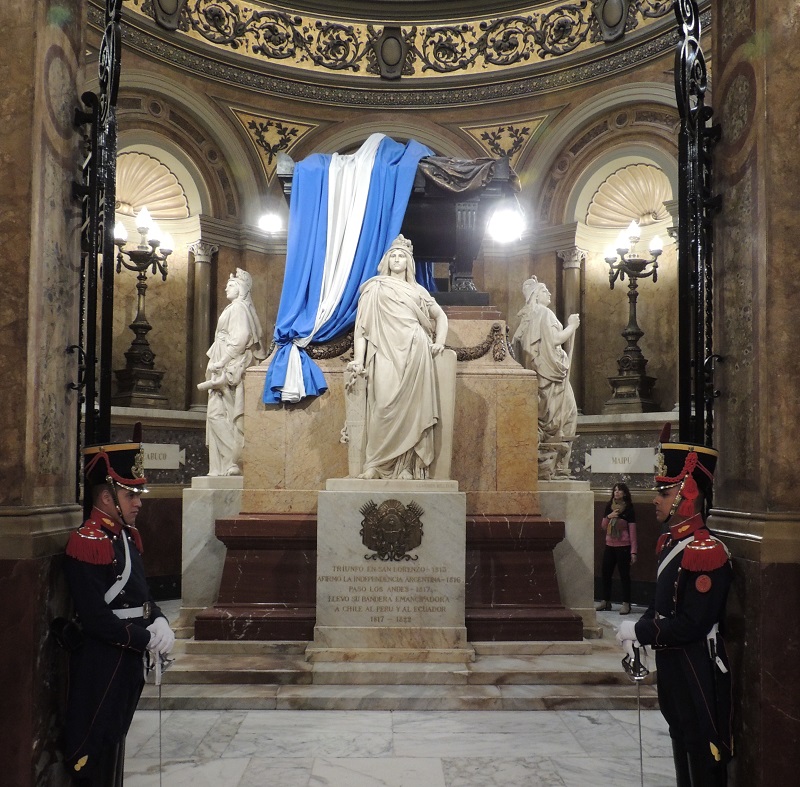
The Catedral Metropolitana is the cathedral of Buenos Aires, and its history goes back to the city’s beginnings. When Juan de Garay founded Buenos Aires in 1580, he laid out the city’s new center and in that connection reserved land for the city’s most important church in the central square of the city plan. The square originally intended by Juan de Garay then also became the home of the Catedral Metropolitana.
There have been several church buildings before the current one on this site. The first church was built shortly after Juan de Garay founded the city, and already in 1605 a replacement was built. The 1605 church was threatened by a structural collapse, and it was therefore rebuilt in 1618, which was two years before it became a bishop’s seat and thus a cathedral.
In the years 1662-1671, the cathedral was expanded; this time to a three-nave church with a wooden roof and a steeple. However, poor materials meant that the roof and tower collapsed in the 1680s, and the church had to be rebuilt. At the end of the 17th century, the new church was almost complete with the exception of the sacristy and two planned side towers. The towers were completed in the 1720s, when the facade was also rebuilt; this time in Italian mannerism.
The church’s structurally tumultuous existence was not, however, because large parts of the cathedral collapsed on 23 May 1752. It was basically only the facade that remained, and a new major building project had to be initiated. Italian Antonio Masella was put in charge of the construction, and he designed a grandiose church with three naves, a barrel vault and a dome over the cathedral’s central cross. After the church was completed, the old facade was too small for the proportions of the new building, and in 1778 it was torn down. They then did not agree on a proposal for a new facade, so the cathedral was inaugurated without a large entrance in 1791.
After several attempts at the beginning of the 1800s, construction of a new facade began in 1826. The design was inspired by the Palais Bourbon in Paris, but construction came to a standstill the year after the start. The last elements of the decoration of the neoclassical entrance ended up being completed at the beginning of the 1860s. The reliefs on the pediment depict Joseph being united with his brothers and father Jacob in biblical Egypt, and it was supposed to be a symbol of the gathering of the Argentine nation.
Inside, the cathedral was laid out with a floor plan like a Latin cross. The walls and ceilings were decorated with various biblical scenes and the work was done by Italian Francesco Paolo Parisi. In 1907, the mosaic floor of the church was laid in the Venetian style, and this design was also Italian. The remarkable altarpiece is from 1785 and thus from the Rococo period of the colonial era. In the church you can also see a work by the Portuguese sculptor Manuel do Coytos. It depicts Buenos Aires’ Christ and dates from 1671, making it the oldest work of art in the cathedral. It is said that the figure miraculously saved the town from flooding in the 18th century.
Inside the cathedral you can also see the mausoleum of General José de San Martín, who is considered the father of the country, and the tomb of the unknown soldier is also here. The mortal remains of José de San Martín came to Buenos Aires from France in 1880, and the mausoleum for him was designed by French Albert-Ernest Carrier-Belleuse. The black sarcophagus is protected by three female statues representing Argentina, Chile and Peru. The three countries were all one in which José de San Martín played a central role in their liberation from Spanish colonial rule.
Obelisco is one of Buenos Aires’ most famous monuments. The striking obelisk stands centrally on the mighty street, Avenida 9 de Julio, which was laid out as the world’s widest boulevard.
The obelisk was erected in 1936 to commemorate Pedro de Mendoza’s first founding of the city 400 years earlier. It was designed by Alberto Prebisch, who is considered one of the most important architects of Argentine modernism.
It took 157 workers just 31 days to build the monument, which has a height of 67.5 meters. However, not everyone was unequivocally happy with the obelisk, and in 1939 the city council of Buenos Aires decided that the monument should be torn down again. However, it was prevented.
The location of the obelisk is interesting in the history of the city, as there used to be an 18th-century church dedicated to Saint Nicholas of Bari here. The church was demolished in 1931 and can thus no longer be seen. The church was where the Argentine flag was first raised in Buenos Aires. It happened in 1812, and the event is mentioned as an inscription on today’s monument.
On special occasions or days to be marked in a special way, the Obelisco has been wrapped for the occasion. This has happened, for example, at international events or when marking relations between Argentina and its trading partners.
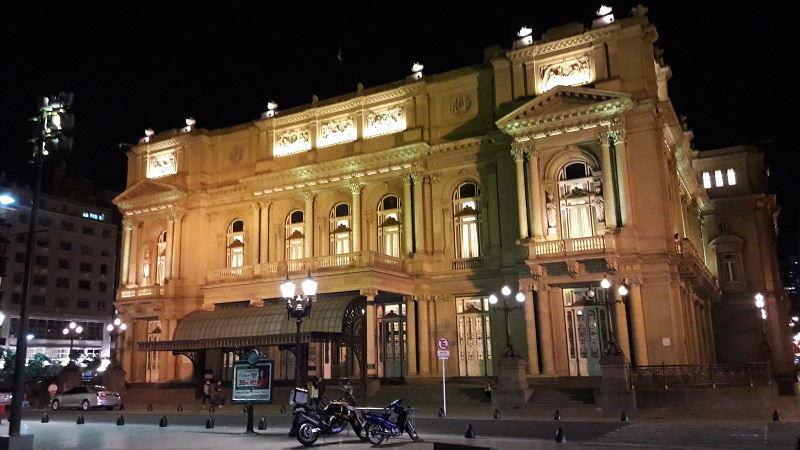
A theater was opened on this site in 1857, and it quickly became so popular that, despite many seats, it had become too small after a few decades. Therefore, it was decided to build a new and larger theater, and it opened in 1908 as the current Teatro Colón. The old theater closed in 1888 to make way for the new one, but due to an economic crisis in 1890, construction was delayed.
The beautiful new Teatro Colón was built and it signaled that the city was culturally on par with places like Paris and New York. The architect was the Italian Francesco Tamburini, and he built an opera that measured itself against the finest in Europe. On 25 May 1908, the theater opened its doors with Giuseppe Verdi’s opera Aida, and since then the stage has been an opera theatre.
The interior is sumptuous with a staircase in Portuguese marble, French furniture and large chandeliers as a few examples of the whole impression, which is topped off by the elegant large auditorium. The acoustics are fantastic and considered one of the best in the world. Over time, stars such as Maria Callas, Plácido Domingo and Luciano Pavarotti have performed here, just as the early 20th century star passed by the Teatro Colón in his time.
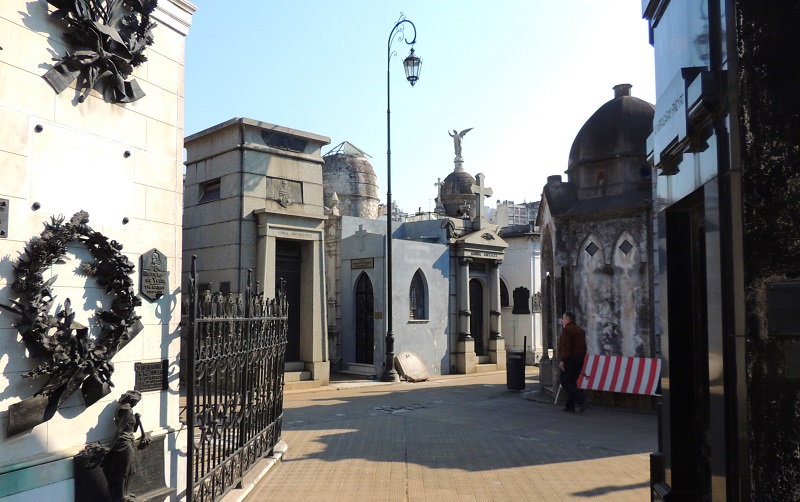
Cementerio de Recoleta is a cemetery in the Recoleta neighborhood. It is also Argentina’s best-known and one of the world’s most beautiful cemeteries, with countless beautiful monuments to many famous Argentines.
The cemetery was built on the outskirts of Buenos Aires in 1822 on the site of a church of the then just dissolved monk order. Since then, more than 6,000 larger or smaller mausoleums have been erected in, among other things, Greek style, art nouveau and deco, and today they almost form a built-up street network in the area.
The highlight for many visitors to Recoleta Cemetery is the grave of Eva “Evita” Perón. Here, many Argentines pass by with flowers. You can also see mausoleums for several Argentine presidents, scientists and members of wealthy families such as the Paz family.
By the way, Juan Perón was not buried at Recoleta. After his death in 1974, he was laid to rest in the La Chacarita cemetery, also located in Buenos Aires. In 2006, he was moved to a mausoleum at Perón’s summer residence in the suburb of San Vicente.
This museum depicts the history of Argentina and provides a distinguished insight into the significant events that have shaped the South American country. It concerns, among other things, the Argentine struggle for independence from Spain.
The museum was founded in 1889 and it opened two years later. After a few years, the exhibition was moved to the current setting, which was built as a residence in 1846. American businessman Charles Ridgley Horne built the Italian-inspired house, and from 1852 to the 1890s it was the residence of the Lezama family.
The museum’s fine collection mainly depicts the country’s development in the period from the 16th to the 20th centuries. Many Argentines have donated effects to the museum over time, and you can see belongings from José de San Martín, Manuel Belgrano and Juan and Eva Perón, among others.
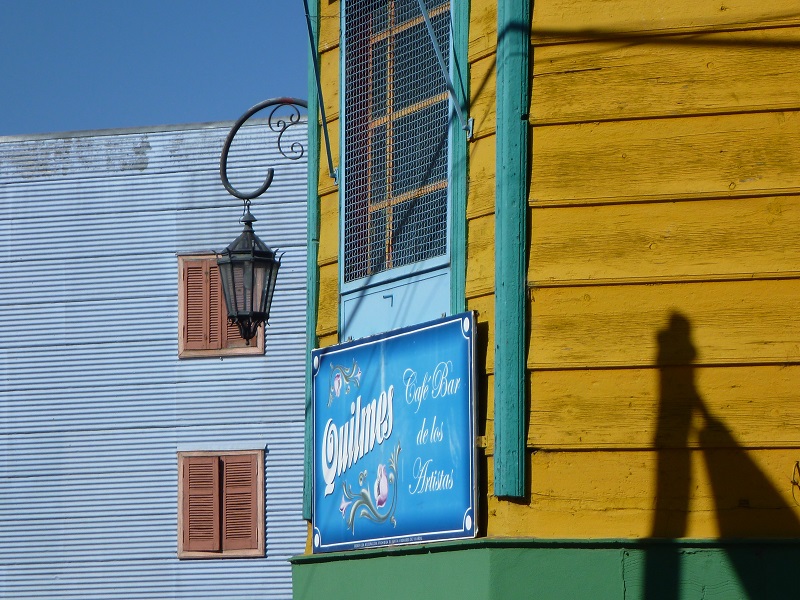
Caminito is La Boca’s main attraction. It is the street with the many brightly colored houses that formerly housed immigrants. The houses are called conventillos and they originally became so colorful because they were painted with leftover ship paint from the nearby port.
In the past, this area of La Boca was the place where Italian immigrants settled, and here prevailed a raw atmosphere as in typical port neighborhoods. Here is now a market, many cozy streets and a number of places where you can dance the tango. Also go down to the city’s old harbour, where there is a view of the distinctive iron bridge over the harbor entrance.
The district of La Boca is a colorful and atmospheric part of Buenos Aires. Originally, the area was the place where many Italian immigrants, mainly from Genoa, settled. There are therefore still many Italian restaurants side by side with the many tango places that help make La Boca so popular with Caminito as a kind of centre.
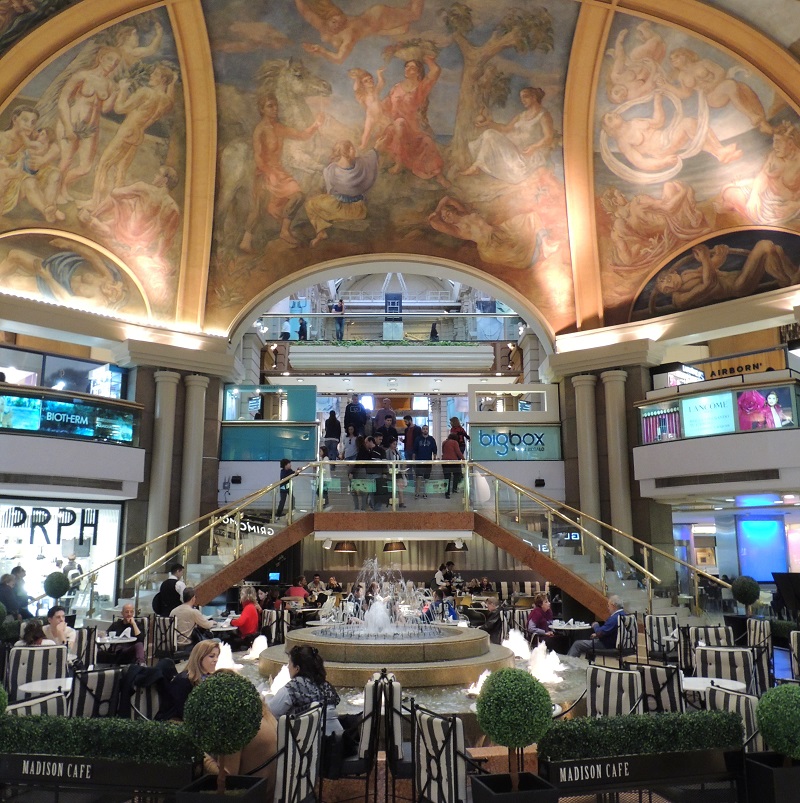
The shopping center Galerías Pacifico is an experience of a shopping center. It opened as the shopping arcade Bon Marché Argentino in 1891, and the inspiration came from Paris and Milan, among others. It was already a well-visited pearl in the city’s shopping area when it opened, and the place still has that status.
Galerías Pacífico was built in beaux arts to a design by architects Emilio Agrelo and Roland Le Vacher from 1889. In 1896, part of the building became the first home of Agentina’s national art museum, the Museo Nacional de Bellas Artes, and in 1908 the railway company Ferrocarril Buenos Aires al Pacifico offices here. The company wanted to connect Buenos Aires with Valparaíso in Chile and thereby create a connection to the Pacific Ocean. The name of the railway company came to give its name to Galerías Pacífico.
During a renovation in 1945, a dome was built in the building, and on 450 m2 of this dome, 12 beautiful ceiling paintings by five different artists were executed. In 1992, the current Galerías Pacífico was set up in the historic building.
Plaza de Congreso is one of Buenos Aires’ beautiful squares and also one of the city’s lovely green areas. The square also forms a kind of formal center in Argentina, as in the eastern part of the park, which is formally called Plaza Mariano Moreno, you can see Argentina’s 0 kilometer stone, the Monolito Kilometro Cero Argentina. The stone forms the central distance point for the national Argentine highways and highways.
Plaza Mariano Moreno is named after politician Mariano Moreno, who played a role in Argentina’s struggle for independence from Spanish colonial rule. Moreno was thus active in the revolution of May 1810, which led to the establishment of the Primera Junta, the first Argentine government. There is a large monument to Moreno in the square here; it was inaugurated in 1910. You can also see one of Auguste Rodin’s casts of The Thinker in this place.
The westernmost part of the green area is the actual Plaza Congreso, and here you can see Argentina’s beautiful congress building and other impressive buildings from the first decades of the 20th century. The square in front of the congress building is dominated by the large fountain De To Forsamlinger/Dos Congresos.
The fountain is a monument to the two parliamentary assemblies from 1813 and 1816 respectively; these were crucial in independence from Spanish colonial rule. The fountain was designed by the Belgian Jules Lagae and inaugurated in 1914. It produces allegorical figures symbolizing the Argentine Republic.
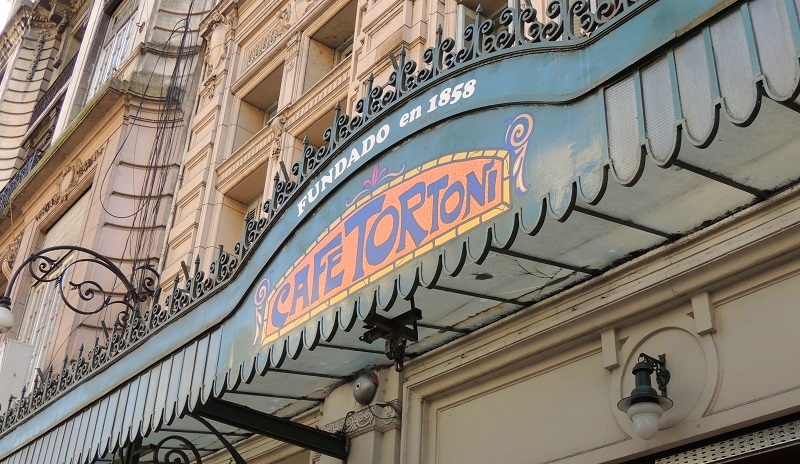
Café Tortoni is a well-known café in Buenos Aires, whose inspiration came from the 19th-century classy Parisian cafés in the French capital. It was the French immigrant Touan who opened the café in 1858. It was later named after Café Tortoni on the Boulevard des Italiens in Paris.
The history of the café is interesting and most of all it is an architectural experience with its preserved interior from the end of the last century.
At the beginning of the 20th century, prosperous Argentina developed rapidly, and fine shops and arcades sprang up in the capital, Buenos Aires. One of these shopping arcades was the Galería Güemes, which was built in the art nouveau style and opened in 1915. It was Italian Francesco Gianotti who designed the building.
The shopping arcade is a passage that is 116 meters long and it connects the streets Calle Florida and Calle San Martín. The arcade was crowned by an 87 meter high tower, and in addition to shops there were a number of apartments in the complex. On the 6th floor, the world famous Antoine de Saint-Exupéry lived temporarily, and it was here that he wrote Vol de Nuit based on his experiences as a pilot in Aeroposta Argentina.
Today, you can still experience the beautiful shopping arcade, which has been restored in recent years. The central dome and details such as the beautiful elevators are interesting to note.
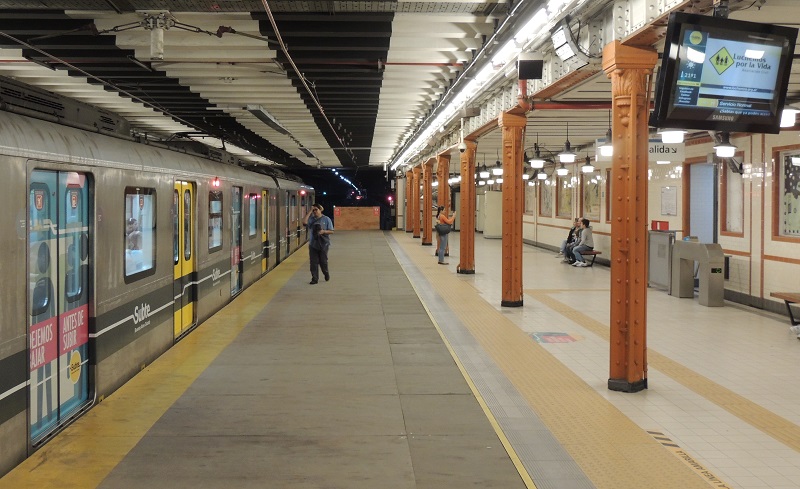
Estación Perú is an attraction located below street level in central Buenos Aires. Estación Perú is a station in the city’s subway network, and it is on the line that opened in 1913 as the first metro in the southern hemisphere.
The metro has expanded significantly since the opening of the first line in 1913, but at Perú station you can step back in time. The station has been renovated so that it is as beautiful as when it opened. This applies both to the structure of the station itself and also to the decoration.
In the early days of Buenos Aires, Puerto La Boca was partially used as a port for passenger and cargo ships, as the area around the new city was not suitable for the purpose. However, the waterway to La Boca was shallow, and the growing number of ships increasingly had to be anchored away from the quays, and barges were used to load and unload the ships.
The city government wanted to deal with the problem so that the Argentine capital could have an efficient industrial port. Local businessman, Eduardo Madero was commissioned to build a new port in 1882, and work began five years later.
Puerto Madero was completed in 1897 with new harbor facilities located immediately east of the city center. The harbor worked as intended, but after a few years the ships had grown so much in size that Madero’s new harbor was too small. The engineer Luis Huergo started the construction of the New Port/Puerto Nuevo, the first parts of which were inaugurated in 1911. Puerto Nuevo was completed in 1926, and even then Puerto Madero was only used to a small extent as a port.
In 1926 and many times thereafter, up to the 1980s, plans were put forward for the rehabilitation of Puerto Madero and the expansion of the areas for housing, but none of these were implemented. Instead, the former port area developed into one of the most run-down areas in Buenos Aires.
In 1989, the Argentine state and the city government of Buenos Aires established a company that partly took over all land interests in Puerto Madero and partly had to ensure a new, urban development on the approximately 170 hectares that were available. The result is clearly visible today, where renovated, old warehouses stand on the west side of Puerto Madero, while new buildings with high-rise buildings, offices, apartments, hotels etc. are to the east. The dock basins from the 19th century are the central part, and you can clearly see that they were built with Liverpool’s famous harbor on the River Mersey as a model.
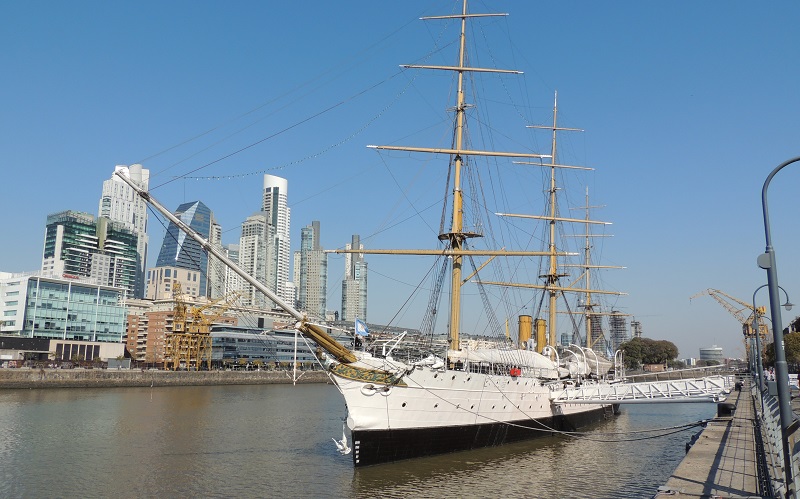
Fragata Sarmiento is a museum ship named after Domingo Faustino Sarmiento, who was president of Argentina in the years 1868-1874. The ship was built in 1897 in Birkenhead in England as a training ship for the Argentine navy.
The frigate has a length of 81 meters and a width of 13 meters. It was active at sea until 1938, when they had made countless voyages and circumnavigations. In the following years it was a training ship on Argentine rivers and later it was active as a stationary training ship.
Today, you can get on board the beautiful ship, which was retired after many years of service in 1961. The ship is largely preserved as it was when it was launched in the late 19th century, and it is thus a beautiful piece of naval history that you can experience at the wharf in Puerto Madero.
Avenida 9 de Julio is a street that was conceived in the late 1880s as a connection between the north and the south of Buenos Aires. However, the project was only realized in the years 1935-1937, when the avenue was laid out as the world’s widest street with a whopping 140 meters from side to side. It was named after Argentina’s Independence Day, July 9, 1816.
The street has seven lanes in each direction in the middle, and on each side there are green plantings and another road with 2 lanes. The width of the street was determined by the city’s existing street network, as the square was created by demolishing a square. Thereby, Avenida 9 de Julio was created through the redevelopment of the city. The length of the street is approximately 4 kilometers from Retiro in the north to Plaza Constitución in the south, and it is an impressive feature of the cityscape with its enormous dimensions.
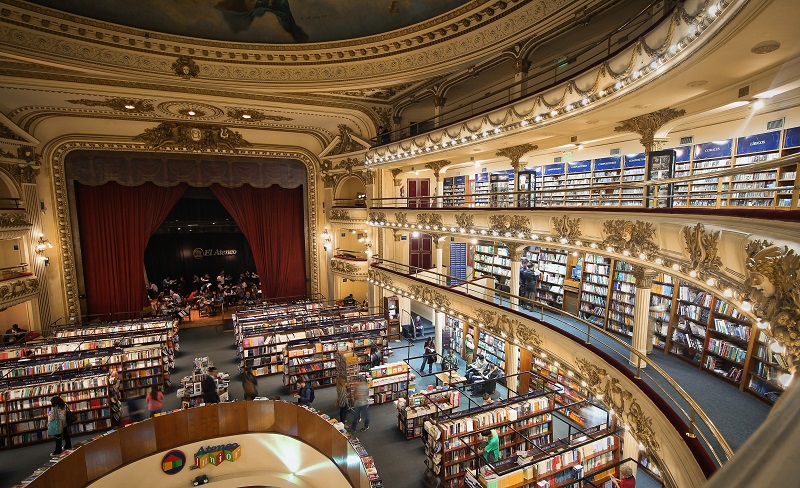
El Ateneo Grand Splendid is a special attraction in the Argentine capital. It is a bookshop that is furnished in some particularly beautiful and impressive settings, which originate from the theater Teatro Grand Splendid.
It was the impresario Max Glücksmann who built and opened the Teatro Grand Splendid in 1919 in an eclectic style with elegant decoration. Italian Nazareno Orlandi was responsible for the theater’s frescoes, while the house’s caryatids were shaped by Troiano Troiani.
The Teatro Grand Splendid had room for 1,050 spectators, and they could see different setups on stage. From the end of the 1920s, the place was also used as a cinema. The name Ateneo comes from the bookstore that is now located in the old building.
Buenos Aires’ botanical garden is a lavish experience of plants and beautiful plants on around 7 hectares. The garden was laid out in the late 19th century by the Frenchman Carlos Thays, and it opened in 1898. Thays himself lived in a mansion in the garden from 1892-1898, and the house from 1881 is still the main building in the green oasis.
You can experience more than 5,000 different growths in the Jardín Botánico, and you can see everything from symmetrical gardens to sculptural gardens with inspiration from, among other things, ancient Rome and Asia. Naturally, you can also see a plant with plants from Argentina, and there are also beautiful old greenhouses here.
The garden has a special function in addition to being a botanical garden. There are many cats in the facility, and they come from families who have surrendered their cats here instead of keeping them at home. Gradually, the many cats were taken care of, so that today they are taken care of by volunteer helpers.
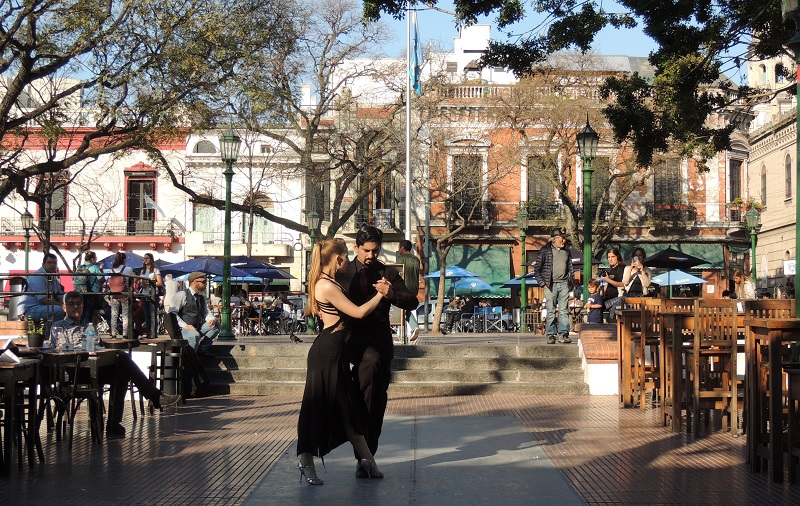
San Telmo is a neighborhood located south of downtown Buenos Aires. It is the city’s oldest quarter, and here there is a special atmosphere that you can enjoy on a stroll in the area, which stands as a lower built-up contrast to the nearby center of the Argentine capital.
In San Telmo you can find tango bars, antique shops, beautiful squares and much more when you walk around the cobbled streets. One should plan a trip past Plaza Dorrego, which serves as the center of San Telmo. Plaza Dorrego is a square where there is often tango.
Mercado San Telmo is a market and market hall centrally located in the cozy San Telmo neighborhood. The market hall was built in 1897 by Juan Antonio Buschiazzo, and the market was established not least for the large wave of immigrants who then came to Argentina and Buenos Aires from Europe.
The place continues to function as a food market with the opportunity to buy many good Argentine ingredients, and around it there are also other stalls and shops. Architecturally, Mercado San Telmo is typical of the late 1800s with tall metal arches and skylights in the market hall.
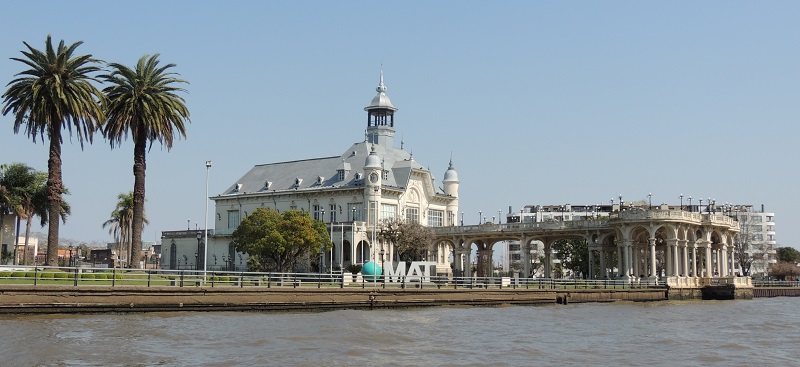
The city of Tigre is a city northwest of Buenos Aires. It is almost like a resort town with several museums, a shopping centre, an amusement park and easy access to exciting sailing trips in the river delta that spreads north of the city.
Tigre was founded in 1820 and its name means tiger, alluding to the jaguars that have historically been seen and hunted here. One of the big attractions in Tigre is the Fruit Port/Puerto de Frutos (Sarmiento), which today is an area with many small shops, cafes and workshops, and the whole area is on the river bank.
You can also take a walk along the port of Tigres and the Luján River along Avenida Victorica. Here are a number of beautiful buildings from, among other things, the belle epoque, and it is also here that you find the Maritime Museum/Museo Naval (Avenida Victorica 602) and the Art Museum/Museo de Arte de Tigre (Saldias 1289).
In Tigre you can also visit the amusement park Parque de la Costa (Vivianco 1509), which is a popular excursion destination from Buenos Aires. The park offers a number of slides and other amusements for children of all ages.
The Paraná River forms a colossal delta in the area northwest of Buenos Aires, which in many ways differs markedly from the nearby metropolitan life in the Argentine capital. The delta is of course a natural gem, but life in the delta itself is also very interesting to follow on one of the many sailing trips you can take through the countless river branches that are available here.
You sail from the town of Tigre, which is the main town for the many people who live permanently or who have holiday homes on one of the delta’s many islands. On a sailing trip you get around and see the many different types of houses from small homes to large mansions, and you can also experience daily life in the form of taxi boats, supply boats and many other service boats.
Along the way on the tour boats, you also sail past some well-known places. The beautiful Tigre Club, which today serves as the Museo de Arte de Tigre (Saldias 1289), is located on the banks of the Luján River. The Tigre Club opened in 1912 next to the now-demolished Tigre Hotel, and both locations were famous meeting places for Buenos Aires’ wealthy.
You usually also sail past a wooden house, which today stands behind a large glass cage that protects it from the weather. The house was the residence of Argentina’s former president Domingo Sarmiento in the years 1855-1888. The house was built in 1855 and has been used as a museum since 1966.

Colonia del Sacramento is a cozy city that is also one of the oldest in Uruguay and known for its old town, which is on the UNESCO World Heritage List. Colonia’s history was marked from the beginning by colonial territorial battles with Portugal and Spain. Colonia was part of Portugal, while Spanish colonial armies besieged and defeated Colonia several times in the late 17th century and throughout the 18th century. Several peace treaties returned the city to Portugal until Spain incorporated Colonia into its empire.
In the first half of the 18th century, Colonia had been significantly expanded with fortifications, and the city was the richest around the Rio de la Plata. Overall, the Rio de la Plata region was economically interesting to both the Spanish and Portuguese empires.

Montevideo is the capital of Uruguay and at the same time one of South America’s large and interesting metropolises in the historic region between Spanish and Portuguese colonies. The city is beautifully located on the northern bank of the Río de la Plata on the site where the Spanish founded it in 1724.
The Fort Fortaleza General Artigas is located at the highest point in Montevideo, and from here there is a magnificent panoramic view of the entire capital and the Río de la Plata, which in this place looks like an ocean. Look forward to a tour through the capital’s cozy neighborhoods, and the old streets and beautiful squares of Ciudad Vieja are a natural starting point. Here you can, for example, enjoy a stroll along Peatonal Sarandí or follow life from one of the city’s plazas.
Avenida Corrientes 3247
Avenida Santa Fe 3251
Calle Florida, Avenida Córdoba
galeriaspacifico.com.ar
Avenida de Libertador 750
Vicente López 2050, Recoleta
Calle Florida, Avenida Santa Fe, Avenida Alvear, Calle Quintana
Museo de los Niños
Avenida Corrientes 3247, Centro Abasto
museoabasto.org.ar
Temaiken Tierra de Vida
Ruta Provincial 25, Escobar
temaiken.com.ar
Parque de la Costa
General B. Miter 2, Tigre
parquedelacosta.com.ar
Fragata Presidente Sarmiento
Av. Alicia Moreau de Justo 900, Puerto Madero
argentinaturistica.com/transpbsas.htm
Buenos Aires and Argentina’s history is best known from all years of European discovery and settlement, but there has also been a past history on the region’s fertile plains and coastal areas. Thus, there had been residents for millennia when the first Europeans arrived.
It was Spanish Juan Díaz de Solís who, as the first European, discovered the area by sailing up the Silver River, Río de La Plata, and it happened in 1516. However, Díaz de Solís’ voyage was short-lived, as he and the other sailors are believed to have been killed along the way by local Charrúa Indians in present-day Uruguay.
It was 20 years after Solís’ first sailing on Rio de La Plata, before a Spanish expedition in search of gold in 1536 founded the first city in today’s Buenos Aires. Pedro de Mendoza was the expedition leader, and he named the city of Ciudad de Nuestra Señora Santa Maria del Buen Ayre. The city was located in the current San Telmo neighborhood and thus not far from the modern center of Buenos Aires known today.
Frequent attacks by local Indians, however, forced the settlers of Buen Ayre on the defensive, and in 1542 the inhabitants of the new town abandoned their houses to flee over the sea and to Asunción, a fortified settlement. As a result, the area around Rio de La Plata was again without European colonization.
The time without Europeans lasted until 1580, when a permanent settlement was established on June 11 by Juan de Garay, who sailed from Asunción in current Paraguay along the Paraná River to Rio de La Plata.
Juan de Garay thereby founded the present Buenos Aires; however, he named it Ciudad de Trinidad with the port of Puerto de Santa Maria de los Buenos Aires. In the first decades, the Spanish administration established itself and the Catholic Church also came quickly to Buenos Aires. In 1591 a Dominican monastery was founded in the city, and in 1604 the Franciscan order was established.
A number of new institutions were founded in Buenos Aires from the very beginning, and it continued in the 1600s with, among other things, a hospital in 1611. Thus, the importance of the port city increased in the Spanish colonial period in South America, which however was ruled from Peru far away from Rio de La Plata.
In 1620, Buenos Aires became the capital of the province of the same name, and the importance of the city for South American trade was greatly increasing. However, the Spanish colonial administration sought to get all trade from South America to physically pass through Lima, Peru; even though part of the shipment of silver, for example, went through Buenos Aires, which was logistically better on the trade route to Spain and Europe than Lima on the Pacific coast.
In the late 1600s, Buenos Aires was a major city centered around the important port of Rio de La Plata. Many new buildings were added during these years, and one of the most important was the inauguration of the city’s cathedral in 1671.
Growth in the late 1600s continued through the 1700s, when Buenos Aires was expanded and more major buildings were added. The town hall, Cabildo, was built in 1711, while several churches, monasteries and hospitals were constructed and opened over the century.
However, the Peruvian trade monopoly as a port of the Spanish Viceroyalty in South America was increasingly a thorn in the eyes of the Buenos Aires traders, who, through the scheme, did not exploit the opportunities they had in the strategically good location at Rio de la Plata. This led to increased opposition to the Spaniards and the Spanish colonial government from the city’s inhabitants. Already at this time the city’s citizens were called Porteños, which means them from the port, which emphasized the importance of the city’s port and thereby the potential for trade.
At the end of the 18th century, the pressure for an easier trade with the outside world was so great that Spanish King Carlos III declared Buenos Aires a free-trade harbor. In addition, the Spaniards created the region around Buenos Aires as the Viceroyalty of Rio de la Plata with the capital of just Buenos Aires. It happened in 1776 and included much of today’s Argentina, Uruguay, Paraguay, Chile and Bolivia.
The new Viceroyalty was created partly to exploit the commercial potential of Buenos Aires and partly to better defend the area against not least England and Portugal’s growing interest in the Spanish territories of South America.
The new status, however, did not create the immediate great progress for the city that was hoped for, and in addition, the reforms came so late that the rebellion against Spanish rule was evident in many places on the continent. The French Revolution was another factor that strengthened the local South Americans’ belief in a successful resistance to the colonial power.
Spain was gradually weakened, and the Napoleonic wars in Europe brought an increasing degree of local autonomy in South America and thereby also in Buenos Aires. In the years 1806-1807, Britain invaded Buenos Aires twice, but local military units both overcame the British. These were events that gave further faith that the colony could stand on its own and defend itself.
In 1810, citizens of Buenos Aires took advantage of the Spanish weakening. They overthrew the Spanish Viceroy, Baltasar Hidalgo de Cisneros, and established an independent provincial government that was not immediately recognized as Argentina’s government. The actions became known as the May Revolution and it was the beginning of independence. The event is celebrated today as National Revolution Day.
With the revolution of 1810, the Spaniards moved the capital of the Viceroyalty to Montevideo, but the revolutions spread to most of Spanish South America, and in 1814 Rio de la Plata ceased to exist as a Spanish colonial kingdom. After 1810, however, Argentina had not become independent, and internal and forces loyal to the viceroyalty also battled each other, but the country’s independence struggle was underway.
In Buenos Aires, the so-called and revolutionary First Junta ruled, which started battles against other parts of the Spanish Viceroyalty. In the Argentine region, for example, there was a great difference between city and country, where conservatism prevailed to a great extent, and for example, it took several years to fight for freedom.
On July 9, 1816, the Tucumán Congress took place in the northern Argentine city of San Miguel de Tucumán. At the congress, the present Argentina, Uruguay and parts of Bolivia declared themselves independent of the Spanish empire. Argentina’s formal independence was assured, and the work of forming an actual state continued with Buenos Aires as its capital.
Buenos Aires was Argentina’s absolute center of trade, politics and population. The city was also the place where the country’s free thinking and liberal thoughts grew, creating a cultural distance to the more conservative population of the rural provinces; it is a difference that continues to prevail today.
Administrative functions was established in the new country, and some institutions were founded in the years and decades after independence. As an example, the University of Buenos Aires was opened in 1821.
With the independence of the country, however, peace was not assured, and from 1838 to 1850 France and Britain sought to strengthen their political positions internationally by repeatedly besieging Buenos Aires. In doing so, Argentina remained an independent nation.
In the latter half of the 19th century, the Argentine catchment area was connected by rail to Buenos Aires, and the transport of raw materials for processing in or shipping from the city created a tremendous growth that made Buenos Aires a metropolis comparable to Europe’s largest.
With the financial success a large-scale cultural expansion also followed in Buenos Aires that would not stand behind the European cities. Great mansions were built and Teatro Colón was built as one of the world’s leading opera houses. The big names in the world often made their way past Buenos Aires, South America’s most successful city.
In 1880, Buenos Aires’ status was changed to a federal territory and Casa Rosada became the seat of the Argentine president. It was a time when the city’s population grew sharply due to a large influx, coming primarily from Italy and Spain.
In the early 1900s, Buenos Aires continued the growth that had begun in the 19th century. The continent’s tallest building was constructed here and the first metro line in South America and the southern hemisphere was built in Buenos Aires. Argentina was not least due to an extremely large meat export among the world’s richest countries, and it could be seen in the capital.
In the 1920s, many European immigrants still came to Argentina, and most of them lived in and around Buenos Aires. Today, the population part of Porteños from European peoples and not from local Indians is much higher than that of other South American metropolitan populations. In the 1930s, many migrants from the Argentine province came to the capital, and population growth began to cause problems.
Immigration created slums as temporary, poor housing opened up around factories in the so-called villas miseria. It was the start of the city’s social problems, which ruled the following decades under changing governments. However, the many new workers also became a political force for Juan Perón and Peronism in Argentina.
Towards the middle of the 1900s, the boom of the previous decades was replaced by the recession that followed the international crisis of 1929 and, following increased competition and consequent declines in exports from Argentina.
Argentina did not participate in World War II, but there was no standstill on the political front in the 1940s. On June 4, 1943, General Arturo Rawson removed the incumbent President Ramón Castillo by a coup. Juan Perón became Minister of Labor and Welfare, where he quickly gained great popularity from not least the working class.
Perón was forced to resign as minister in 1945 and arrested soon after. In protest, people walked the streets immediately after, October 17, 1945, when the masses demanded that Juan Perón be released. The day enrolled in Argentina’s history as the Loyalty Day / Dia de la lealtad, which is counted as the time when Peronism as a political movement was created.
The following year, Juan Perón became president with over half the Argentine votes. His policy aimed to strengthen the conditions of the country’s workers, who were the political base of Perón.
The president nationalized some industry and sought to accelerate industrial development. Despite Juan and his wife Eva Perón’s high popularity and ambitious reform program, Argentina continued to experience financial problems for some time.
Events in 1955 became another historical chapter in the history of Buenos Aires and Argentina. On June 16, many Argentines demonstrated in support of Juan Perón at the Plaza de Mayo, which the country’s military chose to bomb from the air. During the attack, 364 Argentines were killed. In September of that year, the military dismissed Juan Perón as president.
Demonstrations have been held at Plaza de Mayo ever since 1945 due to social problems or in response to changing governments and governance. After many years in exile, Juan Perón returned to Argentina and was re-elected president in 1973. He died in 1974, when Argentina transitioned to a junta rule.
During the latter half of the 20th century, a lot of new construction was built in Buenos Aires. The airports Aeroparque and Ministro Pistarini were opened in 1948 and 1949 respectively, and in 1957 the infrastructure was expanded with the Federico Lacroze station. The city’s metro was also continuously expanded from the opening of the first section in 1913.
In 1967, Buenos Aires’ beautiful Japanese garden was built, and the following year, the city’s planetarium opened its doors. Locals and tourists took advantage of the new opportunities, and in 1971 they were also able to make shopping trips along the Florida street, which was established this year as a pedestrian street.
The 1970s were also a time of political tensions expressed in battles between revolutionary leftist and paramilitary right-wing groups. Juan Perón was president a transition from 1973 to his death in 1974, and from 1976 the country was ruled by the military following a new coup.
The country’s and the city’s financial difficulties continued to be a reality, and despite a popular boom with Argentina’s 1978 World Cup at home, it was difficult times for the country.
Military rule came to war with Britain in 1982 when Argentina invaded the Falkland Islands, which under the name of Islas Malvinas has always been considered Argentine in the South American country. The war was lost and it was one of the steps that resulted in a new political regime with democracy in 1983.
In the 1980s, the pope visited Buenos Aires twice. It happened in 1982 and again in 1987, and both times the event gathered some of the largest number of residents in the city’s history. During the same period, Argentina and Buenos Aires experienced a cultural boom that was complemented by a new economic growth that was particularly evident in the 1990s. By this time, the population of the urban area had grown to over ten million.
Argentina and thereby also the capital was hit by an economic crisis in 1998 due to falling agricultural product prices and a US dollar exchange rate mismatch. The economy gradually improved from the year 2003 in particular, and although there were ongoing financial challenges, the city experienced new optimism with buildings and investments that can be seen now, for example, in the revitalized port district of Puerto Madero. At the same time, the population of the urban area of Buenos Aires has risen, and there are about 14 million people living today.

Overview of Buenos Aires
A trip to Buenos Aires is a meeting with South American atmosphere and countless European-style splendor buildings that make the city unique on the American continent. Buenos Aires was expanded by Parisian example, as Argentina was one of the richest countries in the world, and it is clearly seen in the large and charming city center.
Everywhere there is grand architecture that matches the best of Europe and at the same time creates the city’s very own atmosphere. The central squares, Plaza de Mayo and Plaza Congreso, as well as the stunningly beautiful theater building, Teatro Colon, are fine examples of this. A Calle Florida stroll is also a must, just as tango in San Telmo is also popular.
About the upcoming Buenos Aires travel guide
About the travel guide
The Buenos Aires travel guide gives you an overview of the sights and activities of the Argentinian city. Read about top sights and other sights, and get a tour guide with tour suggestions and detailed descriptions of all the city’s most important churches, monuments, mansions, museums, etc.
Buenos Aires is waiting for you, and at vamados.com you can also find cheap flights and great deals on hotels for your trip. You just select your travel dates and then you get flight and accommodation suggestions in and around the city.
Read more about Buenos Aires and Argentina
Buy the travel guide
Click the “Add to Cart” button to purchase the travel guide. After that you will come to the payment, where you enter the purchase and payment information. Upon payment of the travel guide, you will immediately receive a receipt with a link to download your purchase. You can download the travel guide immediately or use the download link in the email later.
Use the travel guide
When you buy the travel guide to Buenos Aires you get the book online so you can have it on your phone, tablet or computer – and of course you can choose to print it. Use the maps and tour suggestions and you will have a good and content-rich journey.
Rio de La Plata • Porteños • Teatro Colón • Plaza de Mayo

Overview of Buenos Aires
A trip to Buenos Aires is a meeting with South American atmosphere and countless European-style splendor buildings that make the city unique on the American continent. Buenos Aires was expanded by Parisian example, as Argentina was one of the richest countries in the world, and it is clearly seen in the large and charming city center.
Everywhere there is grand architecture that matches the best of Europe and at the same time creates the city’s very own atmosphere. The central squares, Plaza de Mayo and Plaza Congreso, as well as the stunningly beautiful theater building, Teatro Colon, are fine examples of this. A Calle Florida stroll is also a must, just as tango in San Telmo is also popular.
About the upcoming Buenos Aires travel guide
About the travel guide
The Buenos Aires travel guide gives you an overview of the sights and activities of the Argentinian city. Read about top sights and other sights, and get a tour guide with tour suggestions and detailed descriptions of all the city’s most important churches, monuments, mansions, museums, etc.
Buenos Aires is waiting for you, and at vamados.com you can also find cheap flights and great deals on hotels for your trip. You just select your travel dates and then you get flight and accommodation suggestions in and around the city.
Read more about Buenos Aires and Argentina
Buy the travel guide
Click the “Add to Cart” button to purchase the travel guide. After that you will come to the payment, where you enter the purchase and payment information. Upon payment of the travel guide, you will immediately receive a receipt with a link to download your purchase. You can download the travel guide immediately or use the download link in the email later.
Use the travel guide
When you buy the travel guide to Buenos Aires you get the book online so you can have it on your phone, tablet or computer – and of course you can choose to print it. Use the maps and tour suggestions and you will have a good and content-rich journey.

The shopping center Galerías Pacifico is an experience of a shopping center. It opened as the shopping arcade Bon Marché Argentino in 1891, and the inspiration came from Paris and Milan, among others. It was already a well-visited pearl in the city’s shopping area when it opened, and the place still has that status.
Galerías Pacífico was built in beaux arts to a design by architects Emilio Agrelo and Roland Le Vacher from 1889. In 1896, part of the building became the first home of Agentina’s national art museum, the Museo Nacional de Bellas Artes, and in 1908 the railway company Ferrocarril Buenos Aires al Pacifico offices here. The company wanted to connect Buenos Aires with Valparaíso in Chile and thereby create a connection to the Pacific Ocean. The name of the railway company came to give its name to Galerías Pacífico.
During a renovation in 1945, a dome was built in the building, and on 450 m2 of this dome, 12 beautiful ceiling paintings by five different artists were executed. In 1992, the current Galerías Pacífico was set up in the historic building.
Plaza de Congreso is one of Buenos Aires’ beautiful squares and also one of the city’s lovely green areas. The square also forms a kind of formal center in Argentina, as in the eastern part of the park, which is formally called Plaza Mariano Moreno, you can see Argentina’s 0 kilometer stone, the Monolito Kilometro Cero Argentina. The stone forms the central distance point for the national Argentine highways and highways.
Plaza Mariano Moreno is named after politician Mariano Moreno, who played a role in Argentina’s struggle for independence from Spanish colonial rule. Moreno was thus active in the revolution of May 1810, which led to the establishment of the Primera Junta, the first Argentine government. There is a large monument to Moreno in the square here; it was inaugurated in 1910. You can also see one of Auguste Rodin’s casts of The Thinker in this place.
The westernmost part of the green area is the actual Plaza Congreso, and here you can see Argentina’s beautiful congress building and other impressive buildings from the first decades of the 20th century. The square in front of the congress building is dominated by the large fountain De To Forsamlinger/Dos Congresos.
The fountain is a monument to the two parliamentary assemblies from 1813 and 1816 respectively; these were crucial in independence from Spanish colonial rule. The fountain was designed by the Belgian Jules Lagae and inaugurated in 1914. It produces allegorical figures symbolizing the Argentine Republic.

Café Tortoni is a well-known café in Buenos Aires, whose inspiration came from the 19th-century classy Parisian cafés in the French capital. It was the French immigrant Touan who opened the café in 1858. It was later named after Café Tortoni on the Boulevard des Italiens in Paris.
The history of the café is interesting and most of all it is an architectural experience with its preserved interior from the end of the last century.
At the beginning of the 20th century, prosperous Argentina developed rapidly, and fine shops and arcades sprang up in the capital, Buenos Aires. One of these shopping arcades was the Galería Güemes, which was built in the art nouveau style and opened in 1915. It was Italian Francesco Gianotti who designed the building.
The shopping arcade is a passage that is 116 meters long and it connects the streets Calle Florida and Calle San Martín. The arcade was crowned by an 87 meter high tower, and in addition to shops there were a number of apartments in the complex. On the 6th floor, the world famous Antoine de Saint-Exupéry lived temporarily, and it was here that he wrote Vol de Nuit based on his experiences as a pilot in Aeroposta Argentina.
Today, you can still experience the beautiful shopping arcade, which has been restored in recent years. The central dome and details such as the beautiful elevators are interesting to note.

Estación Perú is an attraction located below street level in central Buenos Aires. Estación Perú is a station in the city’s subway network, and it is on the line that opened in 1913 as the first metro in the southern hemisphere.
The metro has expanded significantly since the opening of the first line in 1913, but at Perú station you can step back in time. The station has been renovated so that it is as beautiful as when it opened. This applies both to the structure of the station itself and also to the decoration.
In the early days of Buenos Aires, Puerto La Boca was partially used as a port for passenger and cargo ships, as the area around the new city was not suitable for the purpose. However, the waterway to La Boca was shallow, and the growing number of ships increasingly had to be anchored away from the quays, and barges were used to load and unload the ships.
The city government wanted to deal with the problem so that the Argentine capital could have an efficient industrial port. Local businessman, Eduardo Madero was commissioned to build a new port in 1882, and work began five years later.
Puerto Madero was completed in 1897 with new harbor facilities located immediately east of the city center. The harbor worked as intended, but after a few years the ships had grown so much in size that Madero’s new harbor was too small. The engineer Luis Huergo started the construction of the New Port/Puerto Nuevo, the first parts of which were inaugurated in 1911. Puerto Nuevo was completed in 1926, and even then Puerto Madero was only used to a small extent as a port.
In 1926 and many times thereafter, up to the 1980s, plans were put forward for the rehabilitation of Puerto Madero and the expansion of the areas for housing, but none of these were implemented. Instead, the former port area developed into one of the most run-down areas in Buenos Aires.
In 1989, the Argentine state and the city government of Buenos Aires established a company that partly took over all land interests in Puerto Madero and partly had to ensure a new, urban development on the approximately 170 hectares that were available. The result is clearly visible today, where renovated, old warehouses stand on the west side of Puerto Madero, while new buildings with high-rise buildings, offices, apartments, hotels etc. are to the east. The dock basins from the 19th century are the central part, and you can clearly see that they were built with Liverpool’s famous harbor on the River Mersey as a model.

Fragata Sarmiento is a museum ship named after Domingo Faustino Sarmiento, who was president of Argentina in the years 1868-1874. The ship was built in 1897 in Birkenhead in England as a training ship for the Argentine navy.
The frigate has a length of 81 meters and a width of 13 meters. It was active at sea until 1938, when they had made countless voyages and circumnavigations. In the following years it was a training ship on Argentine rivers and later it was active as a stationary training ship.
Today, you can get on board the beautiful ship, which was retired after many years of service in 1961. The ship is largely preserved as it was when it was launched in the late 19th century, and it is thus a beautiful piece of naval history that you can experience at the wharf in Puerto Madero.
Avenida 9 de Julio is a street that was conceived in the late 1880s as a connection between the north and the south of Buenos Aires. However, the project was only realized in the years 1935-1937, when the avenue was laid out as the world’s widest street with a whopping 140 meters from side to side. It was named after Argentina’s Independence Day, July 9, 1816.
The street has seven lanes in each direction in the middle, and on each side there are green plantings and another road with 2 lanes. The width of the street was determined by the city’s existing street network, as the square was created by demolishing a square. Thereby, Avenida 9 de Julio was created through the redevelopment of the city. The length of the street is approximately 4 kilometers from Retiro in the north to Plaza Constitución in the south, and it is an impressive feature of the cityscape with its enormous dimensions.

El Ateneo Grand Splendid is a special attraction in the Argentine capital. It is a bookshop that is furnished in some particularly beautiful and impressive settings, which originate from the theater Teatro Grand Splendid.
It was the impresario Max Glücksmann who built and opened the Teatro Grand Splendid in 1919 in an eclectic style with elegant decoration. Italian Nazareno Orlandi was responsible for the theater’s frescoes, while the house’s caryatids were shaped by Troiano Troiani.
The Teatro Grand Splendid had room for 1,050 spectators, and they could see different setups on stage. From the end of the 1920s, the place was also used as a cinema. The name Ateneo comes from the bookstore that is now located in the old building.
Buenos Aires’ botanical garden is a lavish experience of plants and beautiful plants on around 7 hectares. The garden was laid out in the late 19th century by the Frenchman Carlos Thays, and it opened in 1898. Thays himself lived in a mansion in the garden from 1892-1898, and the house from 1881 is still the main building in the green oasis.
You can experience more than 5,000 different growths in the Jardín Botánico, and you can see everything from symmetrical gardens to sculptural gardens with inspiration from, among other things, ancient Rome and Asia. Naturally, you can also see a plant with plants from Argentina, and there are also beautiful old greenhouses here.
The garden has a special function in addition to being a botanical garden. There are many cats in the facility, and they come from families who have surrendered their cats here instead of keeping them at home. Gradually, the many cats were taken care of, so that today they are taken care of by volunteer helpers.

San Telmo is a neighborhood located south of downtown Buenos Aires. It is the city’s oldest quarter, and here there is a special atmosphere that you can enjoy on a stroll in the area, which stands as a lower built-up contrast to the nearby center of the Argentine capital.
In San Telmo you can find tango bars, antique shops, beautiful squares and much more when you walk around the cobbled streets. One should plan a trip past Plaza Dorrego, which serves as the center of San Telmo. Plaza Dorrego is a square where there is often tango.
Mercado San Telmo is a market and market hall centrally located in the cozy San Telmo neighborhood. The market hall was built in 1897 by Juan Antonio Buschiazzo, and the market was established not least for the large wave of immigrants who then came to Argentina and Buenos Aires from Europe.
The place continues to function as a food market with the opportunity to buy many good Argentine ingredients, and around it there are also other stalls and shops. Architecturally, Mercado San Telmo is typical of the late 1800s with tall metal arches and skylights in the market hall.
Similar to Buenos Aires Travel Guide